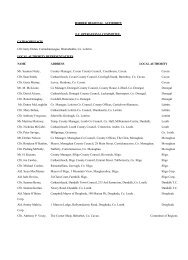downloads/RPGs/Border Regional Authority RPGs 2010-2022.pdf
downloads/RPGs/Border Regional Authority RPGs 2010-2022.pdf
downloads/RPGs/Border Regional Authority RPGs 2010-2022.pdf
Create successful ePaper yourself
Turn your PDF publications into a flip-book with our unique Google optimized e-Paper software.
<strong>Border</strong> <strong>Regional</strong> <strong>Authority</strong> Planning Guidelines <strong>2010</strong> – 2022 – CHAPTER 1<br />
1.4.3 NATIONAL DEVELOPMENT PLAN 2007 – 2013<br />
The National Development Plan (NDP) 2007-2013, sets out a detailed development strategy for the country,<br />
supported by investment in the key areas of infrastructural development, education and training, the<br />
productive sector and the promotion of social inclusion. The NDP also contains a commitment to support<br />
the National Spatial Strategy in the promotion of more balanced regional development throughout the<br />
country.<br />
Many of the key elements of the NDP underpin these common, and interlinked, objectives:-<br />
• Decisively tackle structural infrastructure deficits that continue to impact on competitiveness,<br />
regional development and general quality of life, and to meet the demands of the increasing<br />
population;<br />
• Enhance Enterprise Development, Science, Technology and Innovation, working age<br />
training and skills provision to improve economic performance, competitiveness and our<br />
capacity to generate new enterprise ‘leaders’ from the indigenous sector as well as continue to<br />
attract high added value Foreign Direct Investment (FDI);<br />
• Integrate regional development within the National Spatial Strategy framework of Gateway<br />
cities and Hub towns to achieve the goals of economic growth in the regions, and provide for<br />
major investment in the rural economy;<br />
• Invest in long-term environmental sustainability to achieve the national goal of preserving the<br />
integrity of our natural environment for future generations, as well as meeting international<br />
responsibilities and Climate Change obligations; this also involves a more balanced, efficient and<br />
sustainable use of our land resources;<br />
• Realise the opportunities of strengthened all-island collaboration in areas of mutual<br />
interest to build up the island’s competitive strengths particularly in the areas of infrastructure,<br />
Research and Development (R&D), skills and innovation and to enhance the provision of public<br />
services on the island;<br />
• Deliver a multi-faceted programme for Social Inclusion and improvements in the quality of life<br />
across all age groups, and among all population cohorts; and<br />
• Provide Value for Taxpayers’ Money through robust and transparent appraisal, management<br />
and monitoring systems for NDP investment.<br />
1.5 INTER-REGIONAL ISSUES AND NORTHERN IRELAND<br />
The <strong>Border</strong> Region is bounded by Northern Ireland, the West, Midlands and Mid-East <strong>Regional</strong> Authorities<br />
in Ireland, and its location relative to these is outlined in figure 1.2 below. There are a considerable number<br />
of interregional issues for the <strong>Border</strong> Region, its location being strategic in that it borders with Northern<br />
Ireland and provides a key link between the two principal cities on the Island. It also extends from the busy<br />
eastern corridor to the more peripheral underdeveloped, culturally distinct areas in the west. It is defined in<br />
places by Ireland’s most significant inland waterway, the River Shannon, and has a number of settlements<br />
which straddle borders into other Regions. In this regard, the key interregional matters which will be<br />
addressed and developed with the adjoining Regions and with Northern Ireland, are set out in the diagram<br />
on the following page.<br />
6






